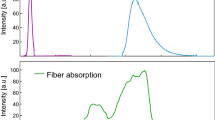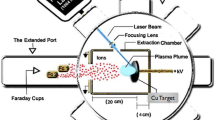Abstract
The effects of different laser incident intensity on the optical characteristics of PM-355 nuclear track detector have been studied by using photoluminescence (PL) and UV–visible spectroscopic techniques. The polymers were irradiated with alpha particles with close contact to 241Am (in contact with a mean energy 5.49 MeV) and then exposed to continues waveguide (cw) laser with different incident intensity. A noticeable decrease in the photoluminescence spectral intensity was observed with increasing laser incident intensity. From the UV–visible spectra, it is found that a shift in the absorption edge towards a longer wavelength with increasing laser incident intensity can be readily observed. The absorption peak with increasing incident intensity is seen to change into a broad one. The optical band gaps determined from the UV–visible spectra were found to decrease with the increase of cw laser doses. The calculations were made of the number of carbon atoms per conjugation length, N and number of carbon atoms per clusters, M embedded in the network of polymers. The effective of etching time on optical power limiting behavior of sample was also investigated. The optical power limiting behavior was found to vary with the etching time. It also shows a very good optical limiting behavior with a limiting threshold varying from 16.6 to 19.9 mW. These results indicate that the PM-355 nuclear track detector is a promising candidate for applications in the nonlinear optic field.









Similar content being viewed by others
References
M. El Ghazaly, H.E. Hassan, Results Phys. 4, 40 (2014)
P.C. Kalsi, C. Agarwal, J. Mater. Sci. 43, 2865 (2008)
T. Sharma, S. Aggarwal, A. Sharma, S. Kumar, D. Kanjilal, S.K. Deshpande, P.S. Goyal, J. Appl. Phys. 102, 063527 (2007)
M.F. Zaki, J. Phys. D Appl. Phys. 41, 75404 (2008)
T. Sharma, S. Aggarwal, A. Sharma, S. Kumar, V.K. Mittal, P.C. Kalsi, V.K. Manchanda, Radiat. Eff. Defects Solids 163, 173 (2008)
K.N. Yu, F.M.F. Ng, D. Nikezic, Radiat. Meas. 40, 380 (2005)
M.A. Rana, Nucl. Instr. Methods Phys. Res. A 592, 354 (2008)
H. Dietrich, Radiat. Meas. 44, 283 (2009)
T.M. Salman, A.Y. Al-Ahmad, H.A. Badran, C.A. Emshary, Phys. Scr. 90, 085302 (2015)
A.M. Abdul-Kader, A. El-Badry Basma, M.F. Zaki Hegazy, T.M. Hashem, M. Hany, Philos. Mag. 90, 2543 (2010)
S. Singh, S. Prasher, Radiat. Meas. 40, 50 (2005)
V. Kumar, R.G. Sonkawade, S.K. Chakarvarti, P. Kulriya, K. Kant, N.L. Singh, A.S. Dhaliwal, Vacuum 86, 275 (2011)
N. Dwaikat, T. Iida, F. Sato, Y. Kato, I. Ishikawa, W. Kada, A. Kishi, M. Sakai, Y. Ihara, Nucl. Instr. Methods Phys. Res. A 572, 826 (2007)
M. Mujahid, D.S. Srivastava, G. Shiuli, D.K. Avasthi, Radiat. Phys. Chem. 74, 118 (2005)
A.M. Abdul-Kader, J. Nucl. Mater. 435, 231 (2013)
H.A. Badran, K.I. Ajeel, H. Gazy Lazim, Mater. Res. Bull. 76, 422 (2016)
H.A. Badran, M.F. Al-Mudhaffer, Q.M. Hassan, A.Y. Al-Ahmad, Chalcogenide Lett. 9, 483 (2012)
H.G. Lazim, K.I. Ajeel, H.A. Badran, Spectrochim. Acta Part A: Mol. Biomol. Spectrosc. 145, 598 (2015)
S. Gupta, D. Choudhary, A. Sarma, J. Polym. Sci. B: Polym. Phys. 38, 1589 (2000)
V. Kumar, R.G. Sonkawade, A.S. Dhaliwal, Nucl. Instr. Methods Phys. Res. B 290, 59 (2012)
M.F. Zaki, T.M. Hegazy, D.H. Taha, Chin. J. Phys. 52, 1364 (2014)
A. Saha, V. Chakraborty, Nucl. Instr. Methods B 168, 245 (2000)
R. Mishra, S.P. Tripathy, D. Sinha, K.K. Dwivedi, S. Ghosh, D.T. Khating, Nucl. Instr. Methods B 168, 59 (2000)
H.A. Badran, Appl. Phys. B 119, 319 (2015)
H.A. Badran, H.A. Sultan, Q.M. Ali Hassan, J. Mater. Sci.: Mater. Electron. 27, 6735 (2016)
Author information
Authors and Affiliations
Corresponding author
Rights and permissions
About this article
Cite this article
Abul-Hail, R.C. Optical limiting behavior correlated with the surface and etching time of irradiated nuclear track detector. J Mater Sci: Mater Electron 28, 2311–2316 (2017). https://doi.org/10.1007/s10854-016-5798-1
Received:
Accepted:
Published:
Issue Date:
DOI: https://doi.org/10.1007/s10854-016-5798-1




